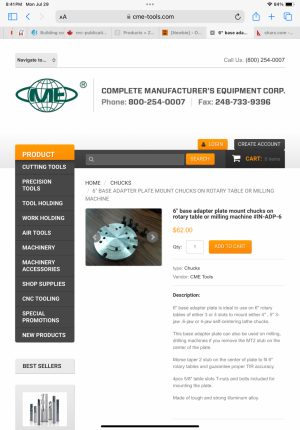Hey all,
Very new to all this and need some advice.
I ordered a VERTEX HV-6 (4-Slot) 6" Horizontal/Vertical Rotary Table with 4-Slot Face Plate which should arrive in a week or so.
It has a MT2 center hole. This will go on a PM727 size mill.


Am I on the right track with looking at this 6" 4 Jaw Independent Chuck and looking to just bolt it down to some t-nuts in the rotary table slots? To me, it saves me from having to drill the chuck or create some backing plate. It also allows me to run a full 6" chuck vs a 5" to allow for bolting to the table.
Thoughts/concerns? Will the chuck sit correctly on the rotary table face when fastened down?

 www.shars.com
www.shars.com


Very new to all this and need some advice.
I ordered a VERTEX HV-6 (4-Slot) 6" Horizontal/Vertical Rotary Table with 4-Slot Face Plate which should arrive in a week or so.
It has a MT2 center hole. This will go on a PM727 size mill.


Am I on the right track with looking at this 6" 4 Jaw Independent Chuck and looking to just bolt it down to some t-nuts in the rotary table slots? To me, it saves me from having to drill the chuck or create some backing plate. It also allows me to run a full 6" chuck vs a 5" to allow for bolting to the table.
Thoughts/concerns? Will the chuck sit correctly on the rotary table face when fastened down?

6" 4 Jaw Independent Chuck
6" 4 Jaw Independent Chuck
More Information| Mfg SKU # | 202-5420 |
|---|---|
| Lathe Chuck Category | Independent Lathe Chucks |
| Brand | Shars Tool |
| chuck diameter | 6 |
| Thru Hole Size | 1.772 |
| mounting | plain back |
| chuck thickness | 2.559 |
| jaw movement | independent |
| Number of Jaws | 4 |


Last edited:



